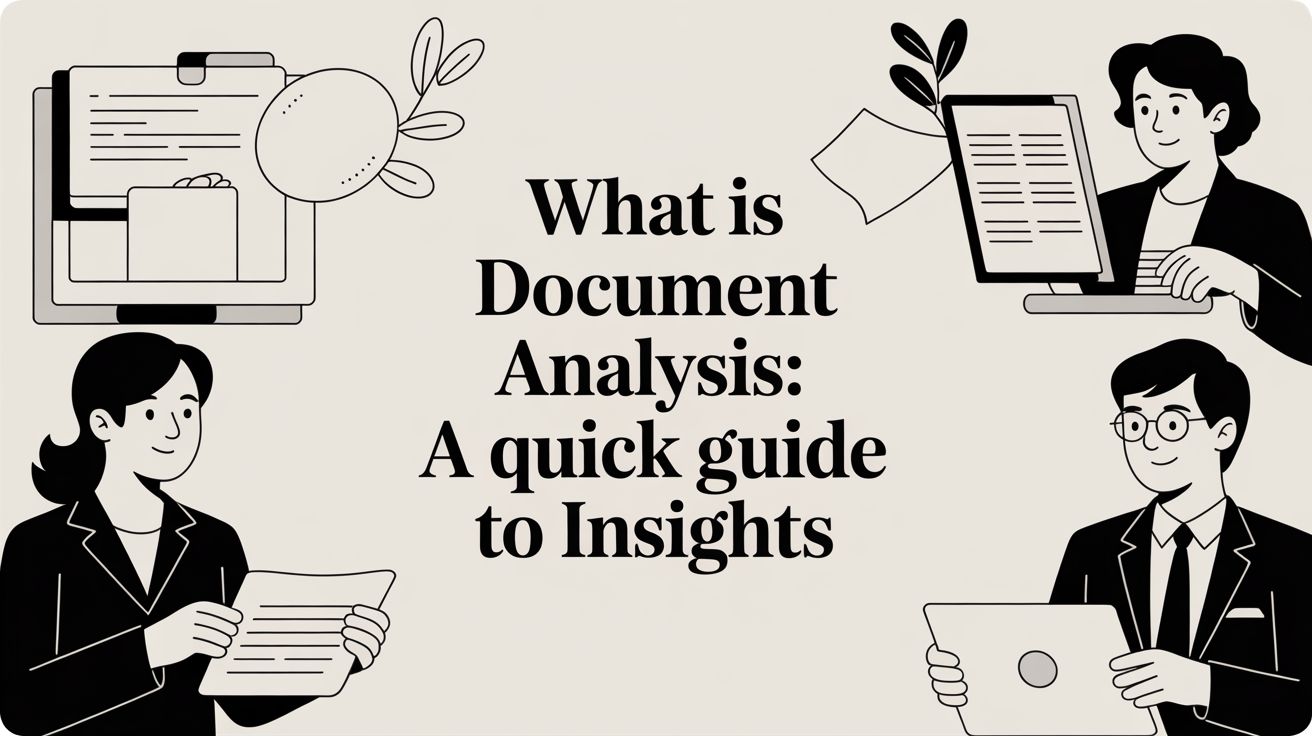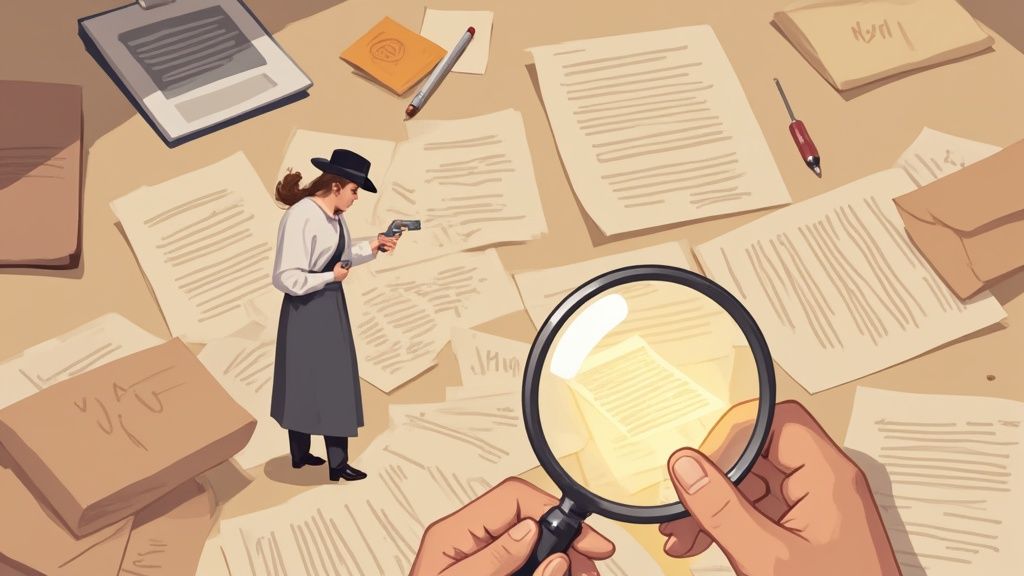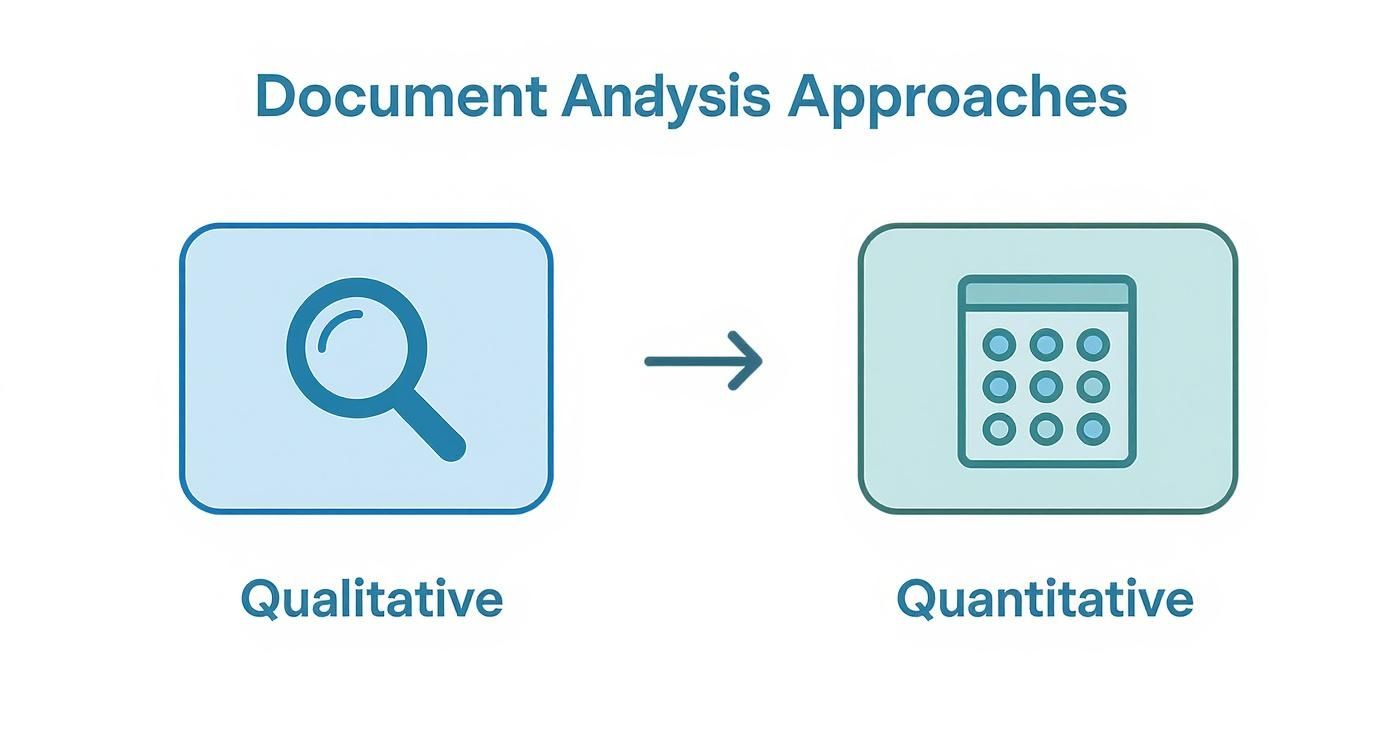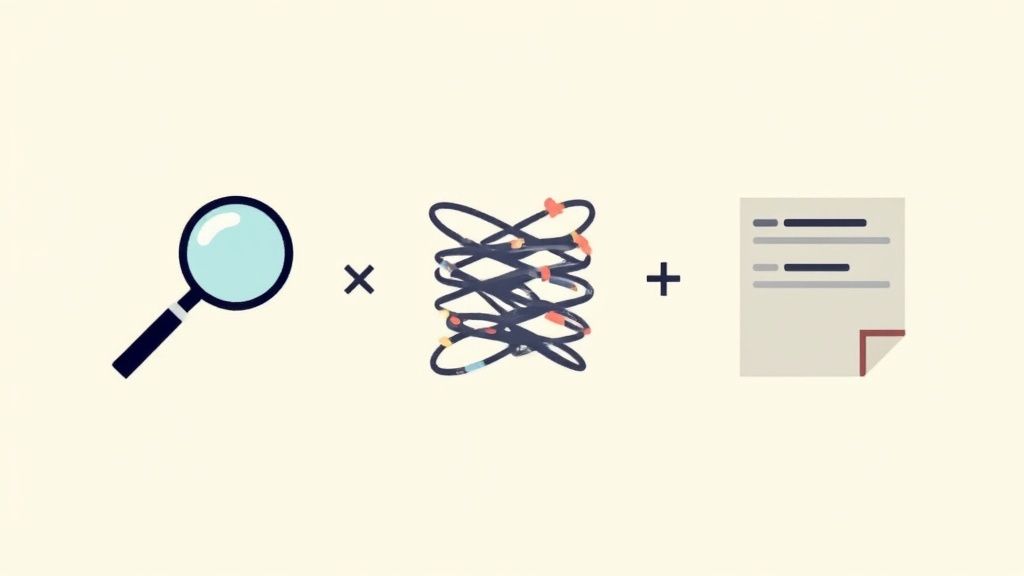What is document analysis: A quick guide to insights
What is document analysis: Discover the methods, real-world examples, and a clear step-by-step approach to extract insights from documents.

Think of document analysis as a form of detective work. Instead of interviewing witnesses, you're gathering clues from existing documents—be they written, visual, or digital—to piece together a story. The entire goal is to sift through this material to uncover hidden patterns, themes, and valuable insights.
What Is Document Analysis Really

Let's make this real. Imagine you want to understand a company's culture but can't talk to a single employee. Where would you start? You’d probably gather their internal memos, public annual reports, and maybe even the company's social media posts.
By carefully reading and cross-referencing these documents, you could start to spot recurring language, identify their stated values, and maybe even find some interesting contradictions. That systematic examination is exactly what document analysis is all about.
It's a structured qualitative research method designed for interpreting and pulling meaningful information from all kinds of existing materials. This approach is a go-to in fields like academia, law, and business because it helps us understand historical events, societal trends, and how organizations actually behave. You can find more details about how this type of data extraction works on Docsumo.com.
The Core Components of Document Analysis
At its heart, the process is about turning raw, messy information into organized, usable evidence. It’s far more than just reading; it’s about systematically breaking down content to answer a specific question.
This method is incredibly versatile. It allows researchers to study the past, evaluate what's happening now, and even make educated guesses about future trends—all based on records that already exist.
Document analysis gives a voice to the materials themselves, allowing them to tell a story that might otherwise go unheard. It provides an unobtrusive way to understand context, history, and meaning without directly influencing the subjects being studied.
To give you a clearer picture, I've put together a quick summary of the method's core components. This table offers a simple snapshot of its purpose and application.
Document Analysis at a Glance
| Component | Description |
|---|---|
| What It Is | A systematic procedure for reviewing and evaluating documents—both printed and electronic material. |
| Primary Goal | To elicit meaning, gain understanding, and develop empirical knowledge from existing sources. |
| Who Uses It | Researchers, historians, legal experts, business analysts, marketers, and social scientists. |
| Common Materials | Reports, emails, letters, meeting minutes, social media posts, policies, and public records. |
This table neatly sums up the who, what, and why of document analysis, showing just how foundational it is for anyone looking to draw conclusions from existing text and media.
The Evolution from Archives to AI
To really get a handle on document analysis today, it helps to see where it came from. For centuries, this was painstaking, manual work. Picture a historian hunched over in a dusty archive, sifting through stacks of wartime letters, trying to piece together military strategies or gauge public morale. Every insight was earned through sheer patience and a sharp eye.
For generations, that was the only way. An analyst's best tools were their own expertise and a meticulous note-taking system. But this approach had an obvious bottleneck: one person can only get through so much. The sheer volume of information often put a hard limit on what could be studied.
From Manual Labor to Machine Speed
The whole game started to shift with the advent of computers. Early systems showed glimmers of a new reality—one where machines could take over the tedious, repetitive tasks, letting human experts focus on the bigger picture of interpretation. A real turning point came when organizations began building automated systems to process their growing piles of electronic documents.
Pioneers like NASA, for example, were developing systems back in the early 2000s that could handle script detection, machine translation, and keyword searches on digital files. This was a massive leap from the old way of reviewing everything by hand. You can find more examples of how these early systems were used in various real-world studies.
The AI-Powered Present
Fast forward to today, and technologies like Optical Character Recognition (OCR) and Artificial Intelligence (AI) have completely changed what's possible. OCR is the magic that turns a scanned page or a picture of a document into searchable, digital text. From there, AI steps in to do the heavy lifting—spotting themes, summarizing key points, and even analyzing sentiment across thousands of documents in minutes.
What once took a researcher months can now be done in the time it takes to grab a coffee. AI doesn't just do the work for us; it scales our own intelligence, letting us ask much bigger questions of much larger sets of data.
This evolution has made document analysis more powerful and accessible than ever before. To get the most out of these tools, it's essential to understand concepts like context engineering for AI, which ensures the AI has the right information to give you accurate, relevant insights. This modern approach takes a classic scholarly method and turns it into a vital tool for navigating our data-filled world.
Qualitative vs. Quantitative Document Analysis
When you dive into document analysis, you’re not following a single, rigid script. The path you take really depends on what you’re trying to find out. Think of it like a geologist examining a rock: are you trying to understand its unique history and composition, or are you trying to measure its exact density and weight?
These two mindsets represent the two main roads in document analysis: qualitative and quantitative. Each one gives you a completely different lens for looking at your materials.
The Detective’s Lens: The Qualitative Approach
Imagine yourself as a detective sifting through clues. That’s the essence of qualitative analysis. You’re not just looking at the surface; you’re digging for the deeper meaning, the hidden context, and the story behind the words. It’s all about understanding the why and the how.
This approach is interpretive, focusing on uncovering themes, patterns of thought, and subtle nuances. A historian reading a soldier's letters from a war zone isn’t just counting the word "battle." They're looking for recurring feelings of hope, despair, or camaraderie to build a rich, human picture of the experience.
Similarly, a company might analyze customer feedback emails to find themes like “confusing checkout process” or “poor customer service.” This isn’t about numbers; it’s about understanding the core of the customer’s frustration. To do this well, you often have to distill complex texts into their main ideas, a skill we cover in our guide on summarizing for better reading comprehension.
The Statistician’s Toolkit: The Quantitative Method
Now, switch hats. Quantitative analysis is about putting on your statistician’s visor. Here, the goal is to turn text into hard numbers that you can measure, count, and analyze. You’re answering questions like what and how many.
This is where you trade deep dives for broad overviews. For instance, a marketing team might scrape 5,000 tweets about their new product. They aren't reading every tweet for its emotional depth; they're counting how many times words like "love" or "amazing" appear versus "disappointed" or "broken." This gives them a clear, data-backed snapshot of public sentiment.
Common quantitative techniques include:
- Word Frequency: Tallying how often specific terms appear.
- Content Categorization: Sorting snippets of text into predefined numerical buckets.
- Statistical Analysis: Running the numbers to find significant trends and correlations.
The real magic happens when you combine both. Quantitative data can tell you what's happening on a massive scale, but it often takes qualitative insight to explain why.
Seeing them side-by-side really clarifies which approach—or which combination of the two—is right for your project.
Comparing Qualitative and Quantitative Approaches
Here’s a quick breakdown to help you decide which method fits your needs. Each has its own strengths, depending on the questions you're asking.
| Aspect | Qualitative Analysis (The 'Why' and 'How') | Quantitative Analysis (The 'What' and 'How Many') |
|---|---|---|
| Primary Goal | To explore and interpret meaning, themes, and context within documents. | To measure frequencies, identify patterns, and test relationships using numerical data. |
| Data Type | Non-numerical data such as text, images, and observations. | Numerical data derived from text, such as counts, frequencies, and scores. |
| Typical Method | Thematic analysis, content analysis (interpretive), and discourse analysis. | Statistical analysis, word frequency counts, and automated content categorization. |
| Example Outcome | A detailed narrative explaining customer motivations based on interview transcripts. | A chart showing that 73% of negative reviews mention the keyword "price." |
Ultimately, choosing between them isn’t about which one is "better." It's about which one will get you the answers you’re looking for.
A Practical Step-by-Step Analysis Framework
Knowing the difference between qualitative and quantitative approaches is one thing, but actually putting that theory into practice is the real challenge. A solid document analysis isn't just about reading; it's about following a structured, repeatable process that turns raw text into a coherent, insightful story. This framework breaks that journey down into five manageable steps.
Think of it like assembling a piece of furniture. You wouldn't just start screwing pieces together randomly, right? You’d lay everything out, glance at the instructions, and follow a logical sequence to get a sturdy, reliable result. Document analysis works the same way.
The visual below shows how qualitative and quantitative analysis take different routes, each progressing from initial review to final insight.

As you can see, the qualitative path is all about deep interpretation (the magnifying glass), while the quantitative path is centered on measurement and counting (the calculator).
Step 1: Define Your Goal and Scope
Before you even touch a single document, you need a clear destination. What specific question are you trying to answer? A vague goal like "I want to analyze customer feedback" is far too broad and will lead you nowhere.
A much better, more focused goal would be: "What are the top three reasons customers requested refunds in the last quarter?" This level of clarity is vital because it dictates your scope—which documents you'll need and what information is actually relevant. Getting this right from the start prevents you from drowning in a sea of data later on.
Step 2: Gather and Organize Your Documents
With a clear goal in hand, you can start collecting your source materials. This might involve anything from downloading annual reports and scraping social media posts to scanning historical letters. If you're working with older physical records, you'll need to digitize them first. Tools like Optical Character Recognition (OCR) tools are a huge help here, turning images of text into machine-readable files.
Once everything is gathered, get it organized. Create a simple spreadsheet that lists each document, its source, and its creation date. This simple log will become your single source of truth and keep the project on track.
Step 3: Develop a Coding System
This is where you start to really break down the content. Coding is simply the process of labeling segments of text with short "codes" or "tags" that represent specific themes, ideas, or sentiments.
Imagine an analyst reviewing customer support tickets. They might use codes like:
- "Pricing Issues": For any mention of cost, subscriptions, or billing errors.
- "Positive Feature Feedback": When a user praises a specific tool or function.
- "Usability Problem": For comments about confusing navigation or clunky workflows.
This coding system becomes your analytical lens, allowing you to categorize information consistently across every single document you review.
Step 4: Conduct the Analysis
Now it’s time to roll up your sleeves and apply your coding system. Go through each document, highlight the relevant passages, and assign the appropriate codes. This is easily the most time-consuming part of the process, but it’s where the real insights finally start to bubble up to the surface.
As you code, you'll begin to notice patterns. Maybe you'll see that "Pricing Issues" spikes every time a new feature is released. This is the moment you start connecting the dots and forming a real narrative from your data.
Step 5: Interpret and Report Your Findings
Finally, step back and look at your coded data as a whole. What story does it tell? It’s time to summarize your key findings, using the patterns you discovered to answer your original research question. This step is especially critical in academic settings, and you can find more tips in our post on how to summarize a research paper.
The ultimate goal is not just to present data, but to provide an interpretation. Your report should explain what you found and, more importantly, what it means in the context of your initial goal.
Document Analysis in the Real World
The theory behind document analysis is one thing, but seeing it solve real-world problems is where its power truly comes to light. This isn't just an academic exercise—it’s a practical tool that shapes critical decisions every day in boardrooms, hospitals, and marketing agencies. Looking at how different fields put it to work shows just how versatile this method can be.
Let's start with the legal field, a place practically built on documents. Picture a law firm navigating a massive corporate merger. They're staring down a mountain of thousands of contracts, each one packed with dense, convoluted legalese. Manually sifting through every line to spot risks or compliance issues would be a monumental task, draining time and money.
This is a perfect scenario for document analysis. Legal teams use sophisticated software to scan, sort, and analyze these contracts in a fraction of the time. The tech can automatically flag specific terms, risky clauses, or even missing signatures. This doesn't just speed things up; it cuts down on human error and frees up lawyers to apply their expertise to the complex problems that could make or break the deal.
Uncovering Insights in Healthcare and Marketing
Now, let's jump over to healthcare. Medical researchers constantly work with huge volumes of patient notes, clinical trial reports, and medical journals. By systematically analyzing this unstructured text, they can spot subtle but critical patterns that would otherwise be impossible to see.
For instance, an analysis might reveal a hidden link between a certain medication and a rare side effect across thousands of anonymized patient records. Discoveries like this can directly lead to updated safety guidelines and better patient care.
Document analysis transforms scattered information into actionable intelligence. It helps professionals move from simply having data to truly understanding what that data means for their organization and the people they serve.
Marketing is another arena where this really shines. Think about a company launching a new gadget. They can analyze thousands of social media posts, blog comments, and online reviews to get a pulse on public opinion. Using sentiment analysis, a type of quantitative document analysis, they can track customer reactions in real time.
Are people loving the new camera? Is a software bug driving everyone crazy? This immediate feedback loop allows them to make quick, informed changes to their marketing messages or even the product itself.
These examples, though from different worlds, share a common theme. Document analysis offers a structured way to pull clear, defensible insights out of a sea of text. The same principles apply in academia, whether you're a grad student learning how to read scientific papers for a literature review or a seasoned researcher looking for a new breakthrough. In every case, it’s about using documents to build an evidence-based foundation for smarter decisions.
Common Mistakes and How to Avoid Them

A great analysis isn't just about following the steps—it's about sidestepping the common traps that can completely tank your credibility. Think of this as your quality control checklist, the one that ensures your findings are solid, reliable, and can stand up to scrutiny.
Even the most carefully planned analysis can go off the rails if you’re not looking out for these key oversights. The most common mistakes I see are personal bias creeping into the interpretation, applying codes inconsistently, and simply forgetting to question the documents themselves.
Overlooking Personal Bias
The sneakiest—and most destructive—mistake is letting your own assumptions color the results. We’re all wired to see what we want to see, but in research, that confirmation bias leads you straight to skewed conclusions.
To fight this, you have to constantly play devil's advocate with your own interpretations. A great trick is to keep a reflective journal during the analysis. Write down your initial thoughts and ask yourself why you're coding a specific passage a certain way. This simple habit forces a wedge between your analysis and your opinions, making sure the findings are actually coming from the data.
Applying Codes Inconsistently
Imagine building a Lego set, but the instructions for what a "red brick" is keep changing. You'd end up with a mess, right? That's exactly what happens when your coding is inconsistent. If "customer complaint" means one thing on Monday and something slightly different on Wednesday, your results will be completely unreliable.
The fix? Create a detailed coding protocol before you even start looking at the documents. This "codebook" is your rulebook, defining each code with crystal-clear examples.
- Code: "Usability Issue"
- Definition: Any user feedback mentioning confusion, frustration, or difficulty using the product's interface.
- Example: "I clicked everywhere but couldn't find the export button."
This protocol becomes your North Star, ensuring every piece of data gets categorized with the exact same logic every single time.
A rigorous and consistent coding system is the backbone of credible document analysis. It transforms subjective reading into a systematic and replicable scientific process, making your conclusions far more powerful and trustworthy.
Failing to Question a Document's Authenticity
Finally, you can't just take a document at face value. You have to put on your detective hat and ask some tough questions. Who wrote this? For what purpose? Who was the intended audience? A polished corporate report is going to have a very different agenda than a hastily written internal email.
Ignoring this context is a rookie mistake. The best practice here is cross-verification. Whenever you can, try to back up claims by checking them against other independent sources. If a memo declares a project a runaway success, do the budget reports and team meeting minutes from that time tell the same story? This is how you build a complete, accurate picture instead of just repeating someone else's narrative.
Frequently Asked Questions
Once you get the hang of what document analysis is all about, a few common questions always seem to pop up. Let's tackle them head-on so you can move forward with a clearer picture.
How Is Document Analysis Different From a Literature Review?
This is a great question, and the distinction is crucial. Think of it this way: a literature review is like surveying the existing landscape. You're reading what other experts have already published to understand the conversation, spot what's missing, and figure out where your own research fits in.
Document analysis, on the other hand, is the expedition itself. The documents aren't just background reading; they are your primary source of data. You're the one digging into them to unearth brand-new insights and conclusions that haven't been published before.
What Types of Documents Can Be Used for Analysis?
Just about any recorded information can be a "document." You're not just limited to formal reports. The scope is massive, which is what makes this method so flexible and powerful.
You could be working with:
- Public Records: Think official government stuff—court records, policy documents, census data, or transcripts of public hearings.
- Personal Documents: This is the intimate stuff. Diaries, letters, emails, and even personal blogs can offer a unique window into individual experiences.
- Organizational Documents: These are the internal records that tell a company's story, like annual reports, meeting minutes, internal memos, and marketing plans.
- Media and Visuals: Don't forget about content from websites, newspapers, social media feeds, photographs, and even films. They're all fair game.
Do I Need Special Software to Perform Document Analysis?
Not always! If you're working on a smaller-scale qualitative study, you can definitely do it manually. A simple spreadsheet or word processor is often all you need to keep track of your codes, themes, and observations.
But once you start dealing with a large volume of documents or want to run any kind of quantitative analysis, specialized software becomes a lifesaver. Tools like NVivo or ATLAS.ti are built for this, and newer AI platforms can supercharge the whole process. They make it possible to manage complex coding and spot patterns across thousands of pages—a task that would be next to impossible by hand.
Ready to speed up your own research? PDF Summarizer uses AI to help you analyze dense reports and research papers in seconds. Chat with your documents, get instant answers with sources, and turn complex information into clear insights. Try it for free at pdfsummarizer.pro.
Relevant articles
Discover how to conduct a literature review with a practical, step-by-step guide covering scope, synthesis, and reporting findings.
